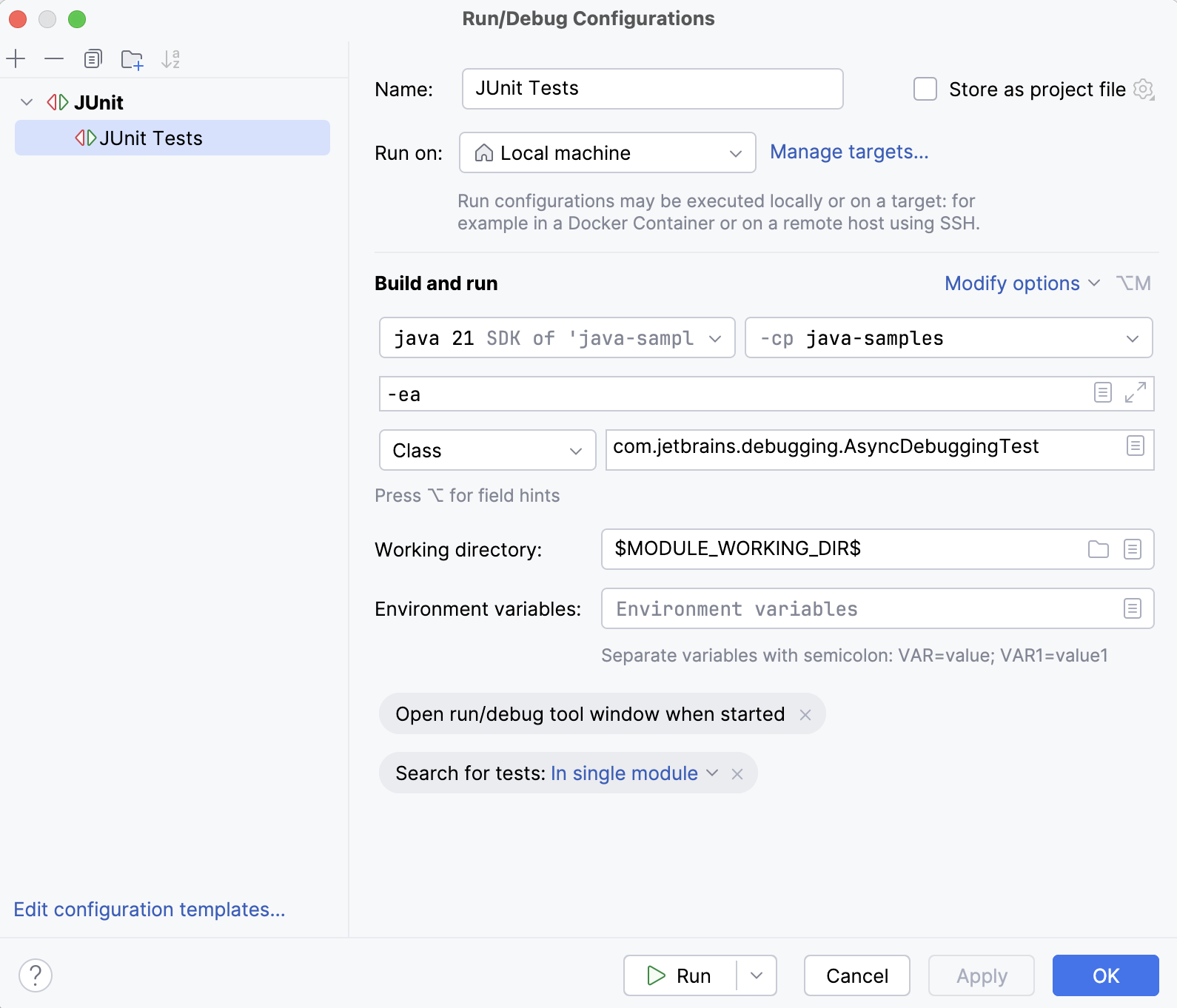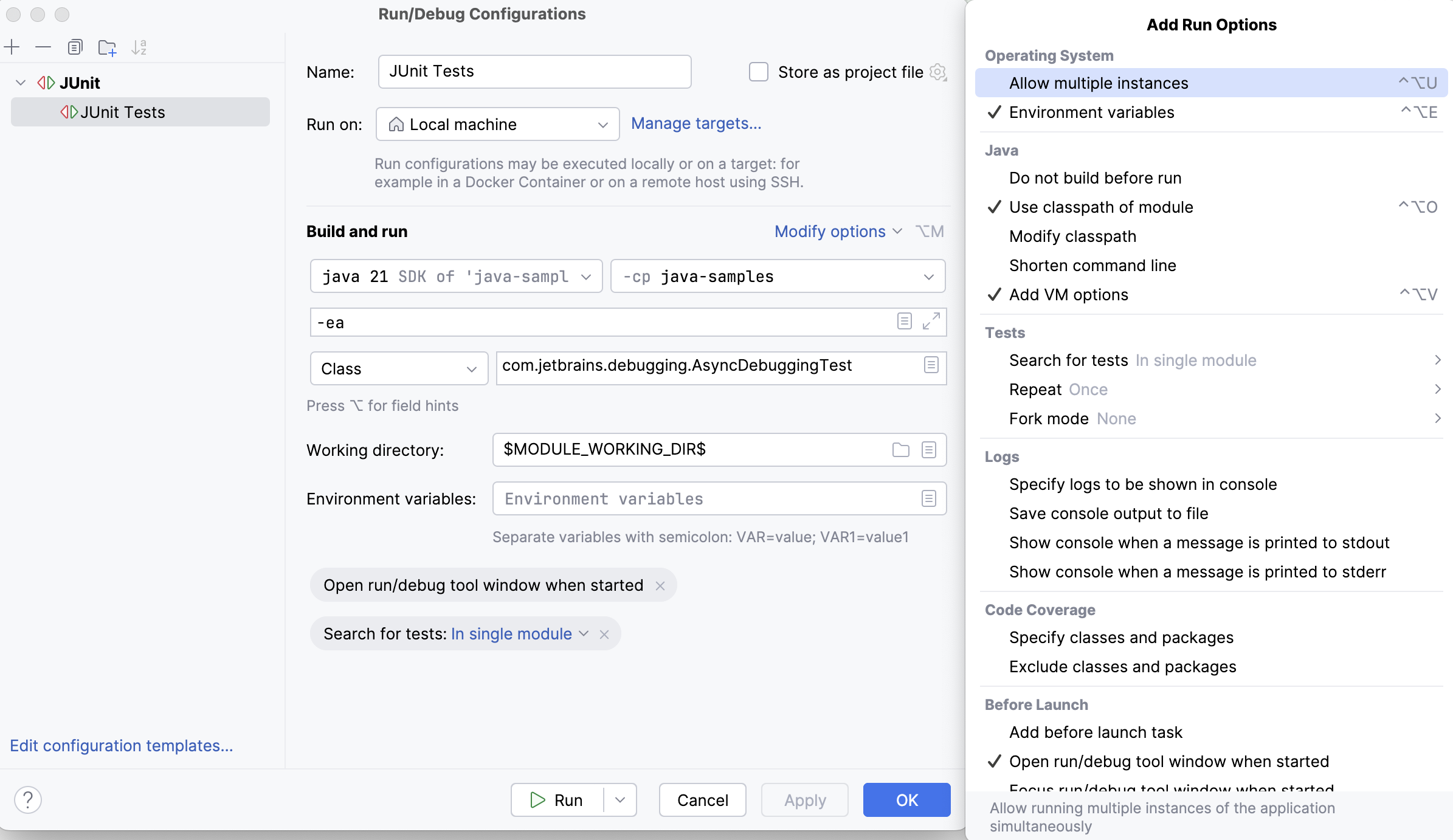Run/Debug configuration: JUnit
JUnit run/debug configurations define how unit tests that are based on the JUnit testing framework should be run.
Create a new JUnit run configuration
In the main menu, go to .
In the Run/Debug Configuration dialog, click
on the toolbar or press Alt+Insert.
The list shows the run/debug configuration templates. Select JUnit.
On the right, you will see configuration options.

Name | Specify a name for the run configuration to quickly identify it among others when editing or running. |
Run on | Select the target environment where you want to run the configuration. Besides running it locally, you can select to run your application on a remote machine via SSH or in a Docker container. For more information, refer to Run targets. |
Store as project file | Save the run configuration settings to a file that you can share with other team members. The default location is .idea/runConfigurations. However, if you do not want to share the .idea directory, you can save the configuration to any other directory within the project. By default, this option is disabled, and IntelliJ IDEA stores run configuration settings in .idea/workspace.xml. |
Required options
Item | Description |
|---|---|
JRE | Specify the runtime environment that IntelliJ IDEA should use to run the application. By default, IntelliJ IDEA uses the latest available JDK from the module dependencies. |
Use classpath of module | Select the module whose classpath should be used to run the application. |
Test kind | From this list, select the scope for your tests and fill in the fields depending on your selection:
|
Working directory | Specify the working directory to be used for running the application. This directory is the starting point for all relative input and output paths. By default, the working directory is the project root. |
More options
To view more options for how to run unit tests that are based on the JUnit testing framework, select Modify options in the Run/Debug Configurations dialog. This will open the Add Run Options dialog.

Operating System
Item | Description |
|---|---|
Allow multiple instances | Allow multiple instances of this run configuration to execute at the same time. By default, this option is disabled, which means that when you run the configuration, other active sessions of the configuration will terminate. |
Environment variables | Click |
Java
The following options are specific to the Java compiler and runtime:
Item | Description |
|---|---|
Do not build before run | Run tests straight away without launching the build process. |
Modify classpath | If necessary, specify another classpath or select dependencies that you want to exclude from the classpath. This option is necessary in cases when the runtime classpath is different from the compile classpath (debug libraries, different locations, and so on). Use the |
Add dependencies with “provided” scope to classpath | Add the dependencies with the provided scope to the runtime classpath. |
Shorten command line | Select a method that will be used to shorten the command line if the classpath gets too long, or you have many VM arguments that exceed your OS command line length limitation. The choice of option depends on the class loader implementation. Note that some frameworks do not support JAR manifest, while other frameworks with custom class loaders will not work well with the classpath.file option.
|
Tests
Item | Description |
|---|---|
Repeat | If you want to repeatedly run a test, select the threshold from this list. You can select to run your test once, |
Fork mode | This option controls how many Java VMs will be created if you want to fork some tests. Select Method or Class to create a separate virtual machine for each method or class respectively. The available options in this list depend on the Test kind setting. |
Search for tests | Select where in your project IntelliJ IDEA will look for test classes related to the current package. This option is available for the All in package, Tags, Pattern, and Category test kinds.
|
Logs
The following options are related to logging the execution of this configuration. For more information, refer to Logs.
Item | Description |
|---|---|
Specify logs to be shown in the console | Specify which log files to display while running the application. Click
For logs in the table, you can configure the following options:
|
Save console output to file | Save the console output to the specified location. Type the path manually or click the browse button and point to the desired location in the dialog that opens. |
Show console when a message is printed to stdout | Activate the console when the application writes to the standard output stream. |
Show console when a message is printed to stderr | Activate the console when the application writes to the standard error stream. |
Code Coverage
The following options are related to code coverage. For more information, refer to Code coverage.
Item | Description |
|---|---|
Specify classes and packages | In this table, specify classes and packages to be measured. Click |
Exclude classes and packages | Specify classes and packages that you want to exclude from coverage. Click |
Before Launch
In this area, you can specify tasks to be performed before starting the selected run/debug configuration. The tasks are performed in the order they appear in the list.
Item | Description |
|---|---|
Add before launch task | Enable this option to add one of the following available tasks:
|
Open run/debug tool window when started | Depending on the type of configuration, open the Run, Debug, or Services tool window when you start this run configuration. If this option is disabled, you can open the tool window manually:
|
Focus run/debug tool window when started | Focus on the run configuration tool window when the tests are running. |
Show the run/debug configuration settings before start | Show the run configuration settings before actually starting it. |